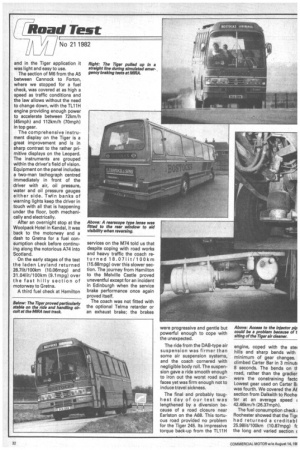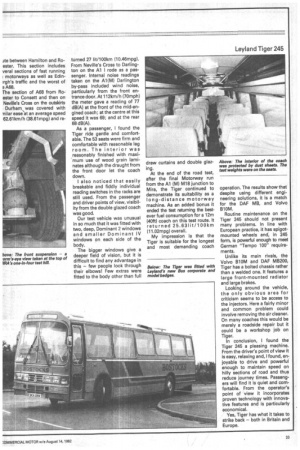Tiger, Tiger, burning bright
Page 23

Page 24

Page 25

If you've noticed an error in this article please click here to report it so we can fix it.
What immortal hand or eye could frame thy fearful symmetry? Leyland's, replies Noel Millier, for it is the Leyland Tiger 245 Duple Dominant-bodied coach and he has just taken it on our most gruelling long-distance test route.
AST YEAR the apes of Gibraltar were joined by a Tiger for a few lays. It was the Leyland Bus Tigris debut and a challenge to the :ontinental manufacturers who ad been eroding the Leyland eopard's market share. Tiger Ilso filled the gap left with the 'wise of the AEC Reliance.
"Tiger strikes back" was the trident cry from LB, but was it a lussyfoot or a blow for Britain? 'here was only one way to find Jut — I took the most powerful If the pack, the 245, round our gruelling long-distance test route.
The test began at the Motor Industry Research Association test track at Nuneaton. The test vehicle was a Duple Dominantbodied machine from the Congleton fleet of E. J. Bostock and Sons. The coach started life as a 218bhp Tiger and had been "upspec-ed" to Tiger 245 after less than a year in service.
MIRA presented no handling or performance problems. It proved sure-footed on the ride and handling circuit and the air suspension was well able to cope with adverse cambers, simulated potholes and level crossings.
Acceleration times and speed in gear tests were equal to the most demanding operator requirements. The brakes stopped the coach quickly and in a straight line during simulated emergency braking tests. It coped easily with the one-in-four test hill.
On the open road I immediately felt at home behind the wheel. All the controls are well grouped in the standard Leyland Bus instrument panel incorpo rated in the Duple surround. I found the small steering wheel comfortable. But the power assisted steering was a little heavier than on Tiger's main two mid-engined Continental competitors. However, it was not excessively heavy and allowed plenty of feel while still making for relaxed driving.
I had previously disliked the smaller wheel which I had found had needed more correction than the larger, more common coach steering wheel. However, during the three days of this test I was converted to the small wheel. It gave me no problems.
On the first section of A5 trunk road the Tiger cruised happily along at the legal maximum speed. The TL11H engine provided enough power and torque to keep up with car traffic and for me to match my speed to that of considerably slower vehicles without the need to change down. The familiar ZF 6.80 sixspeed synchromesh gearbox is now standard on the majority of heavyweight British coaches . and in the Tiger application it was light and easy to use.
The section of M6 from the A5 between Cannock to Forton, where we stopped for a fuel check, was covered at as high a speed as traffic conditions and the law allows without the need to change down, with the TL11H engine providing enough power to accelerate between 72km/h (45mph) and 112km/h (70mph) in top gear.
The comprehensive instrument display on the Tiger is a great improvement and is in sharp contrast to the rather primitive displays on the Leopard. The instruments are grouped within the driver's field of vision. Equipment on the panel includes a two-man tachograph centred immediately in front of the driver with air, oil pressure, water and oil pressure gauges either side. Twin banks of warning lights keep the driver in touch with all that is happening under the floor, both mechanically and electrically.
After an overnight stop at the Woolpack Hotel in Kendal, it was back to the motorway and a dash to Gretna for a fuel consumption check before continuing along the notorious A74 into Scotland.
On the early stages of the test the laden Leyland returned 28.71it/100km (10.06mpg) and 31.0411t/100km (9.1mpg) over the fast hilly section of motorway to Gretna.
A third fuel check at Hamilton services on the M74 told us that despite coping with road works and heavy traffic the coach returned 18.0 7lit/ 1 0 0 km (15.68mpg) over this slower section. The journey from Hamilton to the Melville Castle proved uneventful except for an incident in Edinburgh when the service brake performance once again proved itself.
The coach was not fitted with the optional Telma retarder or an exhaust brake; the brakes were progressive and gentle but powerful enough to cope with the unexpected.
The ride from the DAB-type air suspension was firmer than some air suspension systems, and the coach cornered with negligible body roll. The suspension gave a ride smooth enough to iron out the worst road surfaces yet was firm enough not to induce travel sickness.
The final and probably toughest day of our test was lengthened by a diversion because of a road closure near Earlston on the A68. This tortuous road provided no problem for the Tiger 245. Its impressive torque back-up from the TL11H engine, coped with the ste( hills and sharp bends with minimum of gear changes. climbed Carter Bar in 3 minutt 8 seconds. The bends on th road, rather than the gradier were the constraining facto Lowest gear used on Carter B; was fourth. We covered the AE section from Dalkeith to Roche ter at an average speed ( 42.46km/h (26.37mph).
The fuel consumption check ; Rochester showed that the Tig( had returned a creditabl 25.981it/100km (10.87mpg) fc the long and varied section c Re between Hamilton and Roester. This section includes veral sections of fast running I motorways as well as EdinFrgh's traffic and the worst of e A68.
The section of A68 from Roester to Consett and then on Neville's Cross on the outskirts Durham with , was covered wi nilar ease at an average speed 62.61km/h (38.61mpg) and re turned 27 lit/100km (10.46mpg). From Neville's Cross to Darlington on the Al I rode as a passenger. Internal noise readings taken on the Al(M) Darlington by-pass included wind noise, particularly from the front entrance door. At 112km/h (70mph) the meter gave a reading of 77 dB(A) at the front of the mid-engined coach; at the centre at this speed it was 69; and at the rear 68 dB(A).
As a passenger, I found the Tiger ride gentle and comfortable. The 53 seats were firm and comfortable with reasonable leg room. The interior was reasonably finished with maximum use of wood grain laminates although the draught from the front door let the coach down.
also noticed that easily breakable and fiddly individual reading switches in the racks are still used. From the passenger and driver points of view, visibility from the double glazed coach was good.
Our test vehicle was unusual in so much that it was fitted with two, deep, Dominant 2 windows and smaller Dominant IV windows on each side of the body.
The bigger windows give a deeper field of vision, but it is difficult to find any advantage in this — few people look through their elbows! Few extras were fitted to the body other than full draw curtains and double glazing.
At the end of the road test, after the final Motorway run from the Al (M) M18 junction to Mira, the Tiger continued to demonstrate its suitability as a long-distance motorway machine. As an added bonus it ended the test returning the bestever fuel consumption for a 12m (40ft) coach on this test route. It returned 2 5.6 3lit/1 0 Okm (11.02mpg) overall.
My impression is that the Tiger is suitable for the longest and most demanding coach operation. The results show that despite using different engineering solutions, it is a match for the DAF MB, and Volvo BlOM.
Routine maintenance on the Tiger 245 should not present many problems. In line with European practice, it has spigotmounted wheels and, in 245 form, is powerful enough to meet German "Tempo 100" requirements.
Unlike its main rivals, the Volvo B1 OM and DAF MB200, Tiger has a bolted chassis rather than a welded one. It features a large front-mounted radiator and large brakes.
Looking around the vehicle, the only obvious area for criticism seems to be access to the injectors. Here a fairly minor and common problem could involve removing the air cleaner. On many coaches this would be merely a roadside repair but it could be a workshop job on Tiger.
In conclusion, I found the Tiger 245 a pleasing machine. From the driver's point of view it is easy, relaxing and, I found, enjoyable to drive and powerful enough to maintain speed on hilly sections of road and thus reduce journey times. Passengers will find it is quiet and comfortable. From the operator's point of view it incorporates proven technology with innovative features and is particularly economical.
Yes, Tiger has what it takes to strike back — both in Britain and Europe.














































